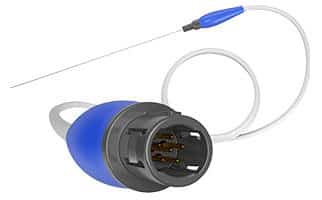Global Interconnect: Single-Use Medical Connectors Design Considerations
In this sponsored content post, Chet Potter, VP of Engineering & R&D at Global Interconnect, shares some tips on design considerations for single-use medical connectors.
With recent advancements in single-use (disposable) medical technologies, OEMs must achieve a single-use medical connector design that’s cost-effective, scalable, and reliable. Some examples of technologies that require single-use medical connectors are catheters, scopes, and probes. These devices are energy-based and require power (high and low voltage), signal, imaging and sensing, and in some instances, the ability to transfer gas, saline, and waste.
For technologies like these, the single-use connetors can be:
- Designed into the handpiece
- Attached to the handpiece via a “pigtail” or “dongle” design
- Attached to a full-length cable that’s hardwired into the handpiece and plugs directly into the console/generator
The selection process should start by understanding the technology’s specific application and user experience for the doctor/hospital, with patient safety at the forefront. This approach will help you confidently select the components, materials, and overall design for your single-use medical connector. Once completed, you are now ready to pursue design considerations for your single-use medical connector.
Design considerations
MATERIAL:
Plastic connectors provide a more competitive price point over metal and are ideal for single-use applications. Common materials to consider are polycarbonate (PC), Acrylonitrile Butadiene Styrene (ABS), and specialty blends of each.
MATING STYLE:
Choosing between locking, non-locking, and a breakaway connector mating style can make a big difference at high volume. Non-locking connectors will offer the least number of components with the most straightforward design and lowest price point. Breakaway connectors provide a slightly more sophisticated design and enhanced user experience over non-locking while maintaining similar price points. Locking connectors offer the most sophisticated designs with additional components but with a slightly higher price point.

CONTACTS:
A primary component and cost driver in connectors involves the contacts. Most contacts require gold plating, which will significantly drive cost, especially as the number of contacts per connector increases. While machined contacts with 30 microns of gold plating are the most common, a stamped pin with gold flash will offer you the lowest-cost option in single-use applications. .7mm and .9mm stamped pins can be leveraged in an industry-standard circular push-pull connector design, while 4mm banana pins are common for industry-standard electrosurgical plugs.
- When the number of electrical contacts per connector becomes increasingly high (8+), edge cards (PCB (Printed Circuit Board) style – FR4) will begin to present the lowest cost options.
- When the number of electrical contacts per connector is five or less, and depending on the application, a TRS, TRRS, TRRRS, and TRS-XL connector might be a viable option.
- Depending on your product application, you may also require pneumatic and fluidic contacts that handle gas, saline and suction.
- Fiber contacts for imaging and sensing are becoming more prevalent and increasingly important for many emerging technologies. Consider fiber contacts for imaging, sensing, and data transmission. However, with the high costs and complexities of fiber, coupled with technological advancements like chip-on-tip, their appeal is diminishing.

Quality, patient safety, and performance should be at the forefront of your design, development, and qualification efforts. Suppliers/partners should be ISO 13485 certified and FDA registered. Your connector must comply with IEC 60601 standards and consist of RoHS 2 materials. Proper qualification and testing should be executed prior to production.
Want to see how a medical device manufacturer saved $7,000,000 with these design considerations? Click Here.
Need reusable solution for your single use. Click Here
Global Interconnect, a Chamfr Service Partner, specializes in helping medical device manufacturers identify the ideal connector solution at any stage of their single-use technology. Engage with their team today and let them help you achieve immediate and long-term success.